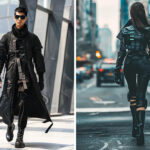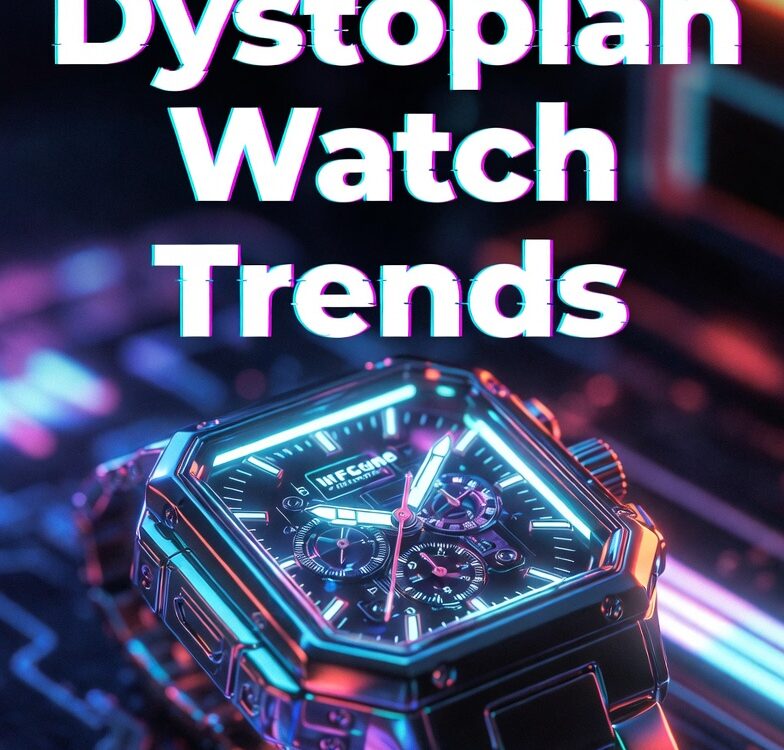
Top Dystopian Fashion Trends You Need to Know for a Bold, Futuristic Look
April 27, 2025
Exploring the Dark Aesthetics of Dystopian Fashion: Outfit Ideas for Every Season
April 27, 2025Fashion has always been a reflection of society — its hopes, fears, triumphs, and downfalls. Today, amidst global uncertainties, climate change, political unrest, and rapid technological evolution, a new aesthetic has emerged: dystopian fashion. What began as a conceptual art form on high-end runways has now trickled down into everyday wardrobes, influencing streetwear in ways few could have predicted.
In this article, we’ll dive deep into the origins of dystopian fashion, how it has evolved, its defining elements, and the impact it has had on modern streetwear culture.
What is Dystopian Fashion?
Dystopian fashion draws inspiration from post-apocalyptic, survivalist, and cyberpunk narratives. It’s a style rooted in themes of resilience, rebellion, utilitarianism, and individualism. The clothing often looks rugged, worn-out, militaristic, and functional — a stark contrast to polished, mainstream trends.
Think dark color palettes, heavy layering, asymmetrical designs, distressed fabrics, technical gear, and a general aura of “preparedness” for an uncertain future.
The Early Roots: How Dystopian Aesthetics Emerged
While dystopian themes have always existed in literature and film, their influence on fashion gained momentum during:
-
The Punk Movement (1970s): Punk fashion, with its DIY attitude, leather jackets, torn clothes, and anarchistic symbolism, laid the groundwork for dystopian aesthetics.
-
Post-Apocalyptic Films (1980s-1990s): Movies like Mad Max, Blade Runner, and The Matrix deeply shaped the visual language of dystopia — gritty, rebellious, and anti-establishment.
-
Japanese Designers (1980s): Visionaries like Yohji Yamamoto and Rei Kawakubo (Comme des Garçons) brought dark, deconstructed, and oversized clothing to global runways, challenging conventional beauty standards.
By the early 2000s, dystopian fashion started gaining traction in high fashion, with designers such as Rick Owens, Gareth Pugh, and Ann Demeulemeester embracing darker, survivalist aesthetics.
Key Elements of Dystopian Fashion
-
Neutral and Dark Color Palettes
-
Dominated by black, grey, olive green, and muted earth tones.
-
Distressed and Deconstructed Fabrics
-
Torn edges, frayed hems, and asymmetrical cuts.
-
Utilitarian Details
-
Cargo pockets, straps, belts, and tactical vests.
-
Heavy Layering
-
Clothing often designed for functionality and protection.
-
Oversized and Relaxed Fits
-
Rejecting traditional tailoring in favor of freedom and fluidity.
-
Technical and Futuristic Gear
-
High-tech fabrics, modular pieces, and cyberpunk accessories.
The Transition: Dystopian Aesthetics Meet Streetwear
Streetwear, historically born from youth culture, skateboarding, hip-hop, and rebellion, shares a natural synergy with dystopian fashion. Both styles thrive on individualism, resistance to norms, and storytelling through clothing.
Here’s how dystopian fashion infiltrated streetwear:
-
Functional Streetwear: Brands began integrating multi-pocket cargo pants, technical vests, and military boots into casual wear.
-
Dark, Edgy Graphics: Apocalyptic imagery, biohazard symbols, glitch art, and cyberpunk motifs became commonplace on streetwear tees and hoodies.
-
Gender Fluidity: Much like dystopian runways, streetwear embraced unisex silhouettes, oversized fits, and fluid identities.
-
High-Tech Fabrics: Waterproof, breathable, and weather-resistant materials became a streetwear staple, thanks to dystopian influences.
-
DIY and Upcycling Movements: Streetwear culture began celebrating customized, patched, and reworked clothing — emphasizing sustainability and uniqueness, key themes in dystopian narratives.
Influential Brands Driving the Dystopian-Streetwear Revolution
Several streetwear and luxury brands have blurred the lines between dystopian fashion and urban street style:
-
Acronym
-
Known for futuristic, techwear designs that blend performance with cutting-edge aesthetics.
-
Alyx Studio
-
Incorporates industrial hardware, tactical elements, and dark, utilitarian designs.
-
Rick Owens
-
His streetwear collections combine avant-garde tailoring with post-apocalyptic vibes.
-
Y-3 (Yohji Yamamoto x Adidas)
-
Merges Japanese avant-garde minimalism with urban sportswear.
-
Guerrilla-Group
-
A Taiwanese label producing militaristic streetwear inspired by dystopian survivalism.
-
Fear of God
-
Focuses on muted tones, oversized fits, and minimalistic, layered designs reflecting a more subdued dystopian vision.
Pop Culture’s Role in Popularizing Dystopian Streetwear
Movies, TV shows, and video games have also propelled dystopian fashion into mainstream consciousness. Major influences include:
-
TV Series: The Walking Dead, Black Mirror, and The 100 showcase survivalist wardrobes.
-
Movies: The Hunger Games and Dune inspire rugged, futuristic, and earth-toned aesthetics.
-
Video Games: Franchises like Cyberpunk 2077 and The Last of Us spotlight tactical gear, layered clothing, and DIY fashion.
Streetwear brands, always attuned to cultural shifts, have tapped into these references to create collections that feel both nostalgic and forward-thinking.
The Psychological Appeal of Dystopian Fashion
Why are so many people drawn to dystopian-inspired streetwear?
-
A Sense of Preparedness: Clothing designed with functionality and survival in mind resonates in times of uncertainty.
-
Self-Expression: Dystopian fashion allows individuals to visually communicate rebellion, resilience, and authenticity.
-
Cultural Reflection: It mirrors society’s collective anxieties about the future, environmental collapse, and technological overreach.
-
Empowerment: Tactical and rugged aesthetics give wearers a sense of strength and readiness.
The Future: Evolving Trends in Dystopian Streetwear
The influence of dystopian fashion on streetwear is far from fading. In fact, it’s evolving:
-
Sustainable and Upcycled Fashion: Expect more brands to embrace sustainability, with recycled materials, upcycled clothing, and zero-waste designs becoming the norm.
-
Biotech and Smart Clothing: Integration of wearable tech, like solar-powered fabrics and self-cleaning textiles, is on the rise.
-
Virtual Streetwear: With the metaverse expanding, digital fashion inspired by dystopian themes is gaining popularity.
-
Minimalistic Survivalism: Future dystopian streetwear might tone down the dramatic silhouettes, focusing more on sleek, functional, and versatile designs for everyday survival.
FAQs About Dystopian Fashion and Streetwear
Q1: Is dystopian fashion only about wearing dark colors?
A: No, while dark colors dominate, dystopian fashion also embraces muted earth tones, metallics, and distressed neutrals to reflect survivalist themes.
Q2: Can dystopian streetwear be stylish and functional at the same time?
A: Absolutely! In fact, functionality is a core part of dystopian fashion’s appeal, blending style with survival gear aesthetics.
Q3: What are some must-have pieces for a dystopian streetwear wardrobe?
A: Key items include tactical vests, cargo pants, combat boots, oversized hoodies, distressed jackets, and technical accessories like utility belts and harnesses.
Q4: Which celebrities are known for rocking dystopian streetwear?
A: Celebs like Kanye West, Billie Eilish, Travis Scott, and A$AP Rocky frequently incorporate dystopian elements into their streetwear looks.
Q5: How can I start incorporating dystopian fashion into my everyday outfits?
A: Begin with subtle pieces like a dark oversized hoodie, cargo pants, or a rugged jacket. Layer with technical or tactical accessories for an authentic vibe.
Conclusion
From high fashion runways to the grungy alleyways of streetwear culture, dystopian fashion has transformed how we dress and express ourselves. It’s more than just an aesthetic — it’s a statement about the world we live in and the world we anticipate.
In a time where uncertainty reigns supreme, dystopian streetwear offers a powerful narrative: one of survival, resilience, and self-expression. Whether you’re wearing a distressed jacket, strapping on a tactical vest, or layering oversized tees, you’re participating in a cultural movement that blurs the line between fashion and foresight.
So next time you zip up your utilitarian jacket or lace your combat boots, remember — you’re not just dressing for today; you’re preparing for the future.



